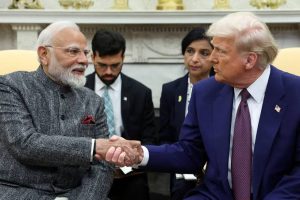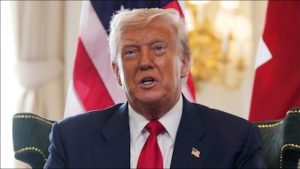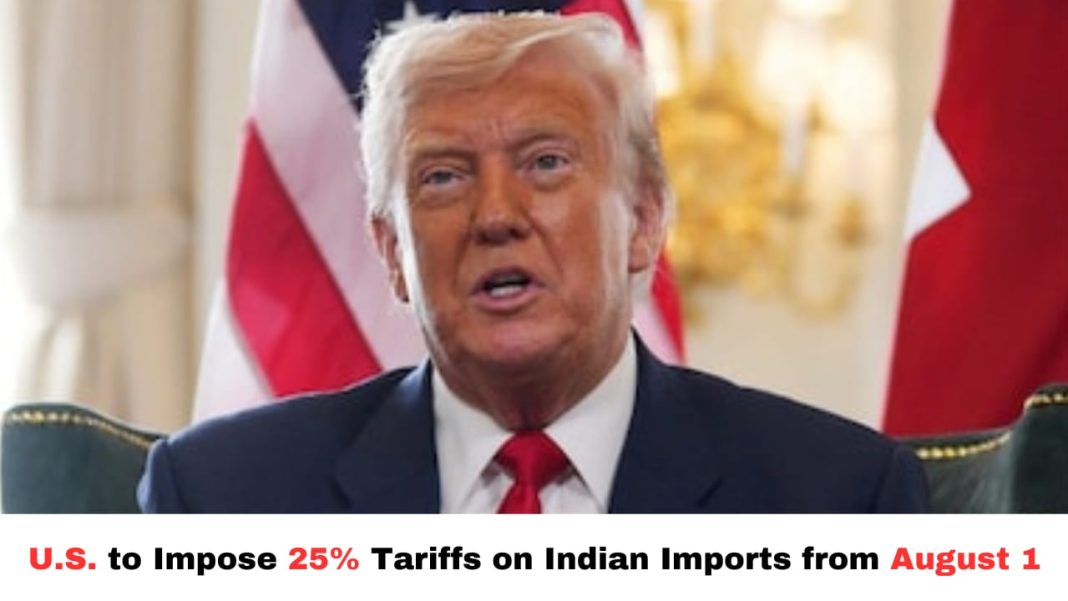Digital News Guru Business Desk:
U.S. Announces 25% Tariff on Indian Goods Effective August 1, 2025
On July 30, 2025, President Donald Trump formally announced that the United States will impose a 25% tariff on Indian imports beginning August 1, 2025. The decision followed protracted bilateral trade talks, which reportedly fell apart mainly over issues of agricultural market access and non‑tariff barriers. Trump also mentioned plans for an unspecified additional penalty, citing India’s ongoing trade with Russia in oil and military goods.
Trump characterized India as a “tariff king”, underscoring U.S. grievances over high Indian average tariffs—estimated around 39% on agricultural products compared to approximately 5% in the U.S.—and Indian restrictions on U.S. goods, despite India remaining among America’s strategic partners.

Negotiations had previously seen tariff threats scaled back from an initial 26% reciprocal tariff (announced April 2, 2025) down to a 10% rate as discussions progressed. However, failure to reach agreement by July caused the deadline to be extended to August 1 via an executive order earlier in the month.
Why Now? Breakdown of Trade Talks
A pivotal point of contention was U.S. market access for Indian agricultural and dairy goods, which New Delhi resisted, citing domestic sensitivities and protections for local farmers. Conversely, India demanded reductions in U.S. tariffs and non‑tariff barriers on its sectors including pharmaceuticals, autos, and machinery.
Indian officials had been negotiating an interim deal that envisioned tariff cuts on 55% of U.S. imports to India worth about $23 billion, while anticipating potential export losses of up to $66 billion if the reciprocal tariff regime took effect. Talks progressed into July but stalled shortly before the deadline, prompting Trump’s announcement.
Industry Reactions: Caution Coupled with Optimism
Sectoral Concerns
Economists and trade leaders across sectors voiced alarm, particularly regarding textiles, gems and jewelry, pharmaceuticals, footwear and footwear—industries heavily reliant on U.S. demand:
- The Gem & Jewellery Export Promotion Council warned that the U.S. market accounts for nearly $10 billion in exports—roughly 30% of global trade in that sector—and that a 25% tariff would impose “immense pressure” on the entire value chain.
- The apparel industry flagged competitiveness issues; small tariff increases could make India 7–10% more expensive than competitors like Vietnam.
- Analysts cautioned that Indian fortunes may hinge on export diversification and value‑chain upgrades, noting vulnerability in electronics and auto components.
Market Forecasts
Despite concerns, some experts believe the impact may be relatively muted:
- At JPMorgan and Morgan Stanley, strategists suggest India’s equity markets are better positioned than many Asian peers to withstand the trade shock, as Indian exporters face moderate tariff hikes compared to regions like China or Vietnam.
- Indian officials maintain their 2025‑26 GDP growth forecast range of 6.3–6.8%, though private economists have dialed estimates down slightly amid tariff disruptions.
Long-Term Strategy and Pivoting
In a more optimistic light, industrial leader Harsh Goenka opined that the U.S. tariff move may catalyze India’s deepening of trade ties with Europe and ASEAN, accelerating its diversification beyond heavy reliance on the U.S. market.
Many Indian industry and policy leaders described the tariff announcement as a negotiation tactic. They expect high-level U.S. delegations in August and hope for a comprehensive trade agreement similar to those recently concluded with Japan or the U.K..

Macro & Market Impacts
Currency and Capital Markets
Indian equities dipped modestly following the announcement, with Nifty 50 hovering near 25,450 as investors braced for potential export shocks and currency volatility. Economists expect sustained pressure on the rupee, prompting possible Reserve Bank intervention to stabilize the currency.
Goods Impact: Some Resilience, Some Risks
Despite tariffs, India’s exports to the U.S. rose to $25.5 billion in April–June 2025 even with a baseline 10% duty already in place. However, sectors like gems and textiles may suffer sharper declines owing to price sensitivity and reliance on U.S. demand.
Retaliation at WTO
India has proposed retaliatory tariffs at the World Trade Organization—notably targeting U.S. autos exports (~$2.9 billion worth)—arguing equivalent compensation for damages under WTO rules.
Outlook: What Lies Ahead?
- U.S. visits to New Delhi in August could lead to a high-stakes negotiation, with hopes of a “TACO style” bilateral trade accord akin to previous deals with Britain or the EU.
- Scope of additional penalty remains unclear. Economists warn that its magnitude could be pivotal in determining the overall economic impact.
- Longer term, India is pressed to accelerate diversification of export markets—pursuing deeper footprints in ASEAN, EU and regional partners to hedge against future trade shocks.
Conclusion
The U.S. tariff decision marks a turning point in India‑U.S. trade relations. While the 25% tariff on Indian goods starting August 1 could strain markets and weigh on key export sectors, many stakeholders view it as a strategic negotiation gambit rather than a permanent policy shift—especially in light of looming talks and global diversification aims.

In the short term, India faces economic turbulence: tightened export margins, heightened market volatility, currency stress and pressure on GDP. In the medium to long term, the episode may accelerate India’s trade realignment—enhancing global competitiveness through expanded engagement with ASEAN, Europe, and beyond.
India’s ability to navigate the evolving trade environment will depend on diplomacy, strategic exports diversification, and building resilience in core sectors like pharma, apparel, gems and auto components.
You May Also Read: Schneider Electric Takes Full Control of Its Indian Business in €5.5 Billion Deal








